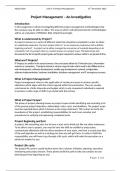Essay
Unit 9 - IT Project Management Assignment 1 (Learning Aim A) DISTINCTION
- Vak
- Instelling
UNIT 9 IT PROJECT MANAGEMENT, COVERS ALL CRITERIA DISTINCTION LEVEL ASSIGNMENT LEARNING AIM A - Investigate the principles and methodologies of IT project management as used in industry P1. Explain, using appropriate definitions, the characteristics of different methodologies applied in IT...
[Meer zien]




